1Department of Restorative Dentistry, King Abdulaziz University Faculty of Dentistry, Jeddah, Saudi Arabia.
2Oral Biology Department, Cairo University Faculty of Dentistry, Cairo, Egypt.
3Endodontic Department, King Abdulaziz University Faculty of Dentistry, Jeddah, Saudi Arabia.
4King Abdulaziz University, Faculty of Dentistry, Jeddah, Saudi Arabia.
5Oral Biology Department, King Abdulaziz University, Faculty of Dentistry, Jeddah, Saudi Arabia.
6Department of Oral and Maxillofacial Prosthodontics, King Abdulaziz University Faculty of Dentistry, Jeddah, Saudi Arabia.
7Department of Oral and Maxillofacial Prosthodontics, King Abdulaziz University Faculty of Dentistry, Jeddah, Saudi Arabia.
8Department of Fixed Prosthodontics, Cairo University Faculty of Dentistry, Cairo, Egypt.
Corresponding author email: gnagieb@kau.edu.sa
Article Publishing History
Received: 12/03/2021
Accepted After Revision: 10/06/2021
The impact of student-generated videos on students’ learning and understanding of specific topics has not been fully examined. Therefore, this study aimed to evaluate the effectiveness of student-generated videos as an educational collaborative learning tool on a group of students’ self-reported perceptions and satisfaction levels in a preclinical dental course. Third-year students enrolled in a biomaterials course—having already taken their prerequisites—participated in this study. They were each asked to produce an educational video on one of the many subjects in their dental course materials. Three years later, these students’ perceptions were assessed with a 26-item, self-administered questionnaire. Data were analyzed using the Statistical Package for the Social Sciences (SPSS). The response rate in this study was 85.7%. The students believed that preparing the video scripts motivated them to read about the topics (52.5%) and to work with a team (55%).Education, Approximately 73% of the students agreed that preparing the videos enhanced their understanding of dental materials and their applications in both the lab and the clinic. About 76% of the participants learned that the video medium can be a powerful communication tool. In addition, the videos improved their understanding of teamwork, as well as their communication, problem-solving, and organizational skills. These videos also improved their responsibility and professional behavior toward their dental teams. Almost all of the students perceived the student-generated video as a contemporary, essential educational tool that enhances student collaborative learning and problem solving, promotes mastery of learning, clarifies various topics, and provides authentic learning opportunities.
Education, Videos, Learning, Thinking, Dental, Gpa, Communication
Naguib G. H, Edrees H. Y, Alshehri S. M, Bukhary S. M, Mously H. A, Hamed M. T. Impact of Student-Generated Videos on Self-Reported Engagement, Critical Thinking and Learning of Saudi Dental Students. Biosc.Biotech.Res.Comm. 2021;14(2).
Naguib G. H, Edrees H. Y, Alshehri S. M, Bukhary S. M. N, Mously H. A, Hamed M. T. Impact of Student-Generated Videos on Self-Reported Engagement, Critical Thinking and Learning of Saudi Dental Students. Biosc.Biotech.Res.Comm. 2021;14(2). Available from: <ahref=”https://bit.ly/3uTNmVV“>https://bit.ly/3uTNmVV</a>
Copyright © Naguib et al., This is an open access article distributed under the terms of the Creative Commons Attribution License (CC-BY) https://creativecommns.org/licenses/by/4.0/, which permits unrestricted use distribution and reproduction in any medium, provide the original author and source are credited.
INTRODUCTION
Lectures have been widely criticized as a learning strategy because they are often associated with frustration, lethargy, or somnolence (McLaughlin and Mandin, 2001). In health professions education, one of the roles of educators is to continuously endorse students’ abilities to practically apply theoretical lessons. During the transition from the preclinical to the clinical phases, a “theory practice gap” may occur due to a lack of linking classroom learning to clinical application (Baxter, 2007). Applying knowledge in practical situations is essential in preparing proficient, skillful practitioners (Mahmoud, 2014).
Thus, educators are challenged to integrate new teaching methods, adapting their approaches to enrich the educational process and satisfy the varying learning needs of their students (Logan, 2012). Pre-recorded videos developed by the course director and student-submitted videos were among the methods recently adopted as a hybrid format that would allow for the development of the fine psychomotor skills necessary in dental hygiene during COVID-19 crisis (Horne et al., 2021)
Dentistry is considered a challenging profession since students must acquire complex cognitive and practical skills and be able to apply these to clinical situations. Beyond this, dental students must continuously improve their clinical judgment and practical skills through ongoing education—including lectures, conferences, and reading assignments—to become competent dental practitioners (Reissmann et al., 2015).
In a recent study, learning dental treatment procedures through e-learning on a smartphone was found to be more effective in developing participants’ understanding of dental treatment procedures and four-handed techniques (Takenouchi et al., 2020).There are many difficulties facing dental students in getting a clear view of the operating field during clinical demonstrations. These include limited operating spaces, the small sizes of oral cavities, and the precise detailed nature of dental procedures. However, these difficulties can be overcome by using video-based learning (Fakhry et al., 2007).
To this end, videos can present knowledge in a clear, structured way, producing better understanding of concepts that are hard to describe through text. In addition, using videos in healthcare is a better way to learn clinical and procedural skills, as well as problem-solving (Gao et al., 2015). More recently videos were reported to be more effective in understanding the pharmacology concepts as measured by the students’ performance in exams (Sumanasekera et al., 2020).
Both medical and dental instructors have had to overcome certain limitations to meet educational needs, including educational staff and instructor shortages, increasing class sizes, fewer patients, and treatment complexities (Walker et al., 2008). Video learning could be useful in helping medical and dental instructors by helping to promote self-directed learning, in which students could view previously recorded clinical procedures before directly performing them on patients (Amer et al., 2011). For instance, the undergraduate Chinese dental students at the University of Hong Kong considered videos to be essential learning tools because they can access them whenever they need, they can easily control the videos’ functions, and they can use these videos in certain situations missing from textbooks or lectures (Botelho et al., 2019).
Crean et al. (2001) described how videos generated by university students can be used as one type of learning tool (Crean, 2001). Among the previously reported benefits of using these videos as learning tools, they are enhancing learners’ motivations and engagement in the learning process. In addition, they are strengthening students’ abilities to communicate effectively and collaboratively with their colleagues (Hanan Omar and Khan, Ajuwon et al., 2016, Shewbridge and Berge, 2004). From the perspectives of the students, they preferred watching video to using conventional learning methods. The application of the enhanced video demonstration resulted in a better theoretical knowledge retention but not practical performance. (Abd-Shukor et al., 2020).
Video-based learning is a popular tool, although its production requires significant time and other resources (Basu Roy and McMahon, 2012). Limited studies have examined the impact of the use of student-generated videos on students’ understanding of the applicable aspects of the preclinical dental courses. Therefore, the aim of this study was to assess dental students’ perceptions and learning experiences, as well as the long-term effects of student-generated videos as educational, collaborative learning tools during a preclinical dental course.
MATERIAL AND METHODS
Ethical Approval : This interventional study was conducted at the Faculty of Dentistry at King Abdulaziz University between September 2015 and 2019. The study was approved by the Research Ethics Committee at King Abdulaziz University, Faculty of Dentistry.
Study Design: A total of 189 third-year dental students (94 female, 68 male) were enrolled in this study after taking their prerequisite classes for the preclinical biomaterials course. After finishing the required lectures, video development was taught to the students as a learning activity. The students were first divided into eight groups. Each group were assigned to create and produce a video on a specific assigned topic of the dental material, and each group was to explain their topic’s composition, properties, uses, advantages, and disadvantages. In addition, they were to demonstrate how to use their subject in the dental clinic or lab. Beyond this, each group had a faculty advisor with experience lecturing on the same or a related topic. Finally, students were given three weeks to prepare their videos.
After producing their videos, students were requested to upload their videos on YouTube and to present them to their classmates in their biomaterials sessions. Meanwhile, a special committee of eight faculty members in different specialties evaluated the videos according to a given rubric and gave feedback to the students.Finally, the students presented their movies to all of the faculty members on a special “Biomaterials movie day.” Next, the students were evaluated by two independent committees, which included eight faculty members from eight different departments. The committees evaluated the content and preparation of the videos, as well as the students’ presentation skills, using a structured rubric prepared for this purpose. After this, they gave the students feedback on their performances. Finalists from both committees were declared, and the winners were awarded certificates of recognition.
Three years later, in the same students’ final year of dental school, the students’ perceptions of their learning experiences during the video creation and their satisfaction with its impact on their skills and knowledge throughout the program were assessed through a questionnaire. This 26-item, self-administered questionnaire was constructed and validated (Cronbach’s alpha 0.951). This questionnaire was distributed anonymously to all the students who participated in the creation of the videos (n = 189).The results were analyzed by using the Statistical Package for the Social Sciences (SPSS), Version 16. The correlation between the rank variables was assessed using Kendall’s test. At last, the percentages were compared for significance using the qi-square test. P values less than 0.05 were considered significant.
RESULTS AND DISCUSSION
The response rate to this study (162 out of 189 students). It was observed that 58% of the students who participated in this study were female, and more than 70% of the participants were between 24 and 25 years. Fifty percent of the students had a GPA between 4 and 4.5 (on a scale from 0 to 5). Regarding the time it took the students to create the videos, approximately 54% of the students took more than one week to complete their videos, whereas about 40% of them needed only one week, as shown in Table 1.
Table 1. Demographics of the participants
| Variable | Number | Percentage |
| Age | ||
| – 22-<23 | 3 | 1.9 |
| – 23-<24 | 40 | 24.7 |
| – 24-<25 | 115 | 71 |
| – 25-<26 | 4 | 2.5 |
| Gender | ||
| – Male | 68 | 42 |
| – Female | 94 | 58 |
| GPA | ||
| – <3 | 2 | 1.2 |
| – 3-3.5 | 7 | 4.3 |
| – 3.5-4 | 61 | 37.7 |
| – 4-4.5 | 81 | 50 |
| – 4.5-5 | 11 | 6.8 |
| How long does it take to perform the video | ||
| – Less than a week | 10 | 6.2 |
| – A week | 65 | 40.1 |
| – More than a week | 87 | 53.7 |
As for the students’ video preparation processes, approximately 55% of them believed that access to the information in their video was easy to attain. They added that preparing the scripts made them read more on their topics (52.5%), which enhanced their understanding of these topics (52.5%) and encouraged them to work in teams (55%). Beyond this, there was no significant difference in students’ satisfaction with their benefits from the video preparation process, as shown in Figure 1.
Figure 1: Students perception regarding the process of video preparation.
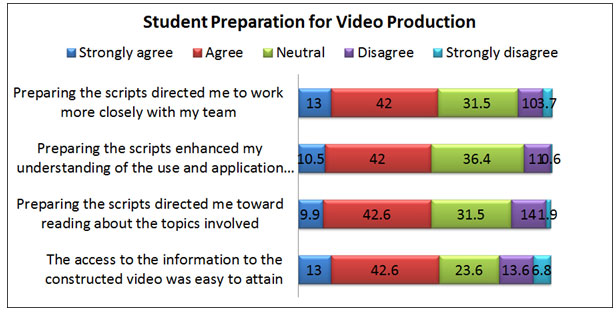
The issue that most satisfied the students concerning the videos was that the latter were organized in such a way that it was easy to search and review information for each instrument (72.9%). Furthermore, approximately 67% were satisfied with the design of their videos and 60% with the look, with no significant difference in students’ satisfaction with any of the video parameters, as shown in Figure (2).
Figure 2: Students’ level of satisfaction with their dental material videos
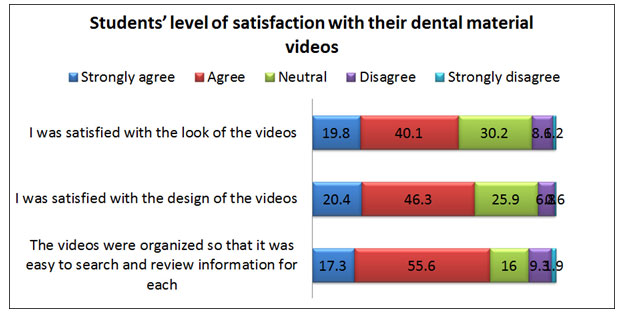
Overall, the students’ were satisfied with their video-based learning experience. In fact, a considerable percentage of the students thought that video creation improved their language and communication (69.8%), organizational (60.5%), problem-solving (55.5%), and project management skills (54.9%). However, there was no significant difference between these skills, as shown in Figure (3).
Figure 3: Students’ perception about skills developed during participation in video creation.
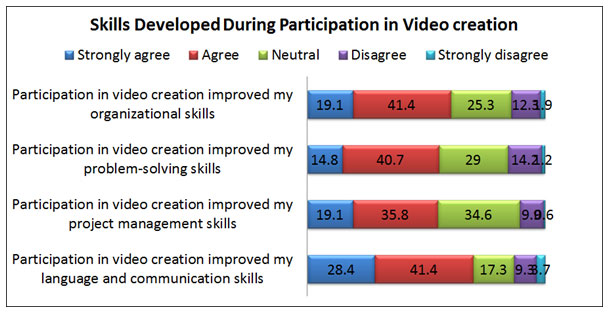
Among the benefits reported by the students about watching videos were that they improved their understanding of the composition of dental material (72.8%), the properties of this material (71%) and the safety precautions in their preclinical labs (63.6%). On the other hand, no significant difference was found between these benefits, as shown in Figure (4). Similarly, there was no significant correlation between the GPAs and overall satisfaction of the students who generated the videos (r = 0.056, p = 0.43) or their willingness to participate in a similar activity in the future (r = 0.042, p = 0.55), as shown in Table (2).
Figure 4: Students’ perception about benefits of watching videos.
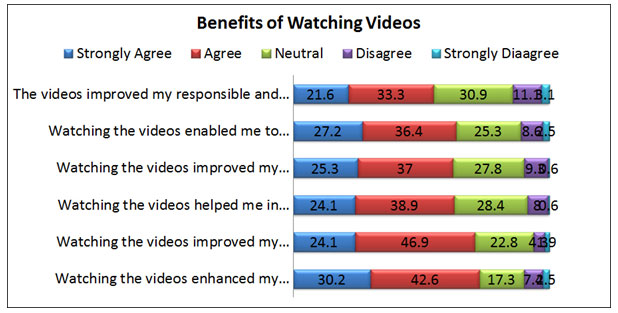
Table 2. Correlation between GPA and overall satisfaction with the video creation
| Overall, this activity was worthwhile. | I would like to participate in this type of activity again | |||
| Correlation coefficient | P value | Correlation coefficient | P value | |
| GPA | 0.056 | 0.43 | 0.042 | 0.55 |
Approximately 33% of the students participating in the video creation activity thought it was worthwhile, and 47% of them noted that they would like to participate in video creation again and would recommend this activity to other students in the future. Moreover, a significantly (p < 0.05) higher percent, 76%, of the participants learned that the video medium can be a powerful communication tool, as shown in Figure (5).
Figure 5: Students’ perception about the general aspects of learning through video generation. * Significant (p<0.05).
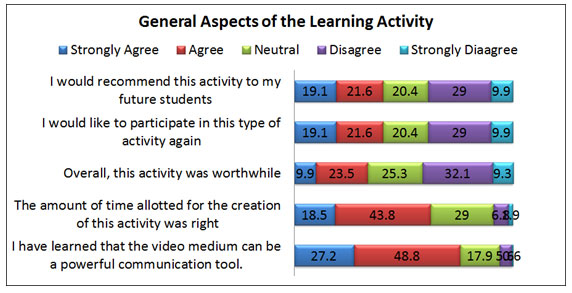
Transferring practical skills obtained through didactic sessions into clinical practice is considered a challenging process for undergraduate dental students. In order to accomplish this aim, these students need particular training on procedures and demonstrations in hands-on sessions (Wong et al., 2019a). E-learning has been reported to effectively support medical and clinical education, as people learn efficiently through multimedia, which is thus significant in medical education (Jang and Kim, 2014).
Transferring practical skills during teaching sessions could be enhanced by using visual aids, including images and audio recordings. Current evidences suggest that the use of videos in teaching practical skills and techniques has many benefits in pedagogy. It has been reported that videos attract attention and involve students in practicing necessary skills, as such teaching methods allow them to communicate facts and demonstrate procedures (Wong et al., 2019a).
On the other hand, a recent study was conducted to investigate the effectiveness of an in-class and on-demand enhanced video to support learning on removable partial dentures in terms of knowledge acquisition, perception and clinical skill performance. They reported that enhanced video demonstration improved the students’ short-term knowledge acquisition compared to the non-enhanced group. The practical performance did not differ between the two groups. The students were more likely accept the enhanced video as a replacement of the existing teaching method rather than a teaching supplement (Abd-Shukor et al., 2020)
In this study, a large percentage of the participants reported that student-created videos enhanced their understanding of the topics of the biomaterials course—e.g., the composition and properties of dental materials, as well as the safety precautions required in the preclinical lab. These findings were in line with those of (Wong et al., 2019a). They reported that the content provided through visual aids could establish a connection between handling and recalling of knowledge by controlling functionality.
In this way, students can review components of complex techniques to achieve better processing of clinical procedures. In addition, this format motivates students, stimulating deep learning and improving the learning process in general. Their study reported that using videos to supplement traditional class instruction could help students develop cognitive skills, enhancing their performance and increasing the knowledge they retained (Cooper and Higgins, 2015, Wong et al., 2019b). This was evident in this study as well.
Confirming this conclusion, the fourth- and fifth-year dental students reported that video learning materials allowed them to clarify knowledge, improve cognitive thinking, and enhance revisions of theoretical concepts and clinical skills (Botelho et al., 2019). On the same note, such videos supply audiovisual stimuli and can enhance different teaching conceptions (Farooq and Al-Jandan, 2015). Therefore, using video has been endorsed in dental education (Kalwitzki et al., 2011). In a recent study, using instructional video showing the light-curing technique was comparable to individual verbal instruction and an effective tool for teaching the light-curing technique per the students’ ability to deliver sufficient amounts of irradiance and radiant exposure to simulated cavities (Al-Zain and Al-Osaimi, 2021).
In the dental field, video education has shown numerous benefits in both teaching and training (Edrees et al., 2015). Although using videos to deliver content has been practiced for many years, videos have yet to be implemented in all dental schools. In a previous study, communication and treatment procedures were among the aspects perceived as beneficial by dental students at Karolinska Dental Institute in Stockholm, Sweden, after patient demonstration videos were given in predoctoral endodontic education (Edrees et al., 2015). These findings were in agreement with this study. The students reported a positive experience with the video creation because it enhanced their language, communication, organizational, problem-solving, and project management skills and required them to work in a team.
Such reactions were consistent with another study, which found that the student-generated video activity was used to introduce an early appreciation of the clinical role and responsibilities of a dentist in the dental program (Haron et al., 2012). In addition, it increased students’ autonomy, promoted active learning, and provided the opportunity for group learning, as well as language development (Haron et al., 2012). A recent Saudi study was performed to evaluate using videos, either watched or student-generated, for teaching stronger interpersonal communication skills to dental students. They found that using videos in teaching communication skills was effective and added that producing videos had more benefits than simply watching videos (Al-Khalifa and Gaffar, 2021).
Although the dental students reported in more than one study that they preferred video-based teaching to traditional teaching, there have been mixed findings on the effect of video-based teaching on students’ grades and performance (Chi et al., 2014, Kyaw et al., 2019). In a previous study, video cases used by dental students in an introductory public health dentistry course were reported to be associated with significantly higher mean scores and were effective in helping students achieve cognitive and affective objectives, in contrast with paper cases (Chi et al., 2014). On the other hand, the meta-analysis conducted by Kyaw et al. (Kyaw et al., 2019) revealed that there was no statistically significant difference in post-intervention skills scores between digital education and traditional learning.
In addition, it was concluded that there were no statistically significant differences in post-intervention skills or knowledge scores between the blended traditional and online or offline digital education and traditional learning alone (Kyaw et al., 2019). These studies supported the findings of this study, as there was no significant correlation here between the academic performance scores of the students and their overall satisfaction with the generated videos.
The students were asked to upload their videos on YouTube, which is one of the most popular media services and is available to anyone with internet access. The use of YouTube in dental education has been shown to sometimes play a complementary role in dental teaching, but it should not be used without validated instructional material (Aldallal et al., 2019). Students independently wrote the scripts and directed their videos, and most of the videos were of acceptable quality.YouTube can be used as a tool to supplement dental education due to its easy accessibility. It provides many sources of information that can be used by those working in the dental field or preparing to instruct dental students (Mukhopadhyay and Suryadevara, 2014). One unexpected finding in this study was that students weren’t interested in participating again in this kind of activity, which could be due to the condensed content of the third-year dental curriculum, which gave them little availability.
Recall bias given the three-year lag between when the students participated in the video creation and when the students were surveyed could be one of the limitations of this study. Among the limitations as well, was the inability to measure the students’ retention of knowledge and applications of skills learned from the student-generated videos. Therefore, there is a need for further research assessing the long-term efficiency of these videos in the areas of knowledge or skills retention. Another limitation was the activity evaluation, which was based mainly on students’ perceptions. Thus, more thorough evaluation of students’ performance should be considered.
CONCLUSION
To summarize, the results of this study showed that almost all students positively perceived the video-based learning and teaching. More specifically, they perceived the student-generated videos as relevant, vital educational tools that enhance student collaborative learning, promote mastery of learning, and increase understanding of topics in the field. Students’ own video recording can be used for further research discussion and stimulate critical thinking.
Declarations
Ethics approval and consent to participate: The study was approved by the research ethics committee at King Abdulaziz University, Faculty of. Accepting to fill the questionnaire was considered as a consent to participate.
Consent for publication Not applicable
Availability of data and materials: The data will be made available upon request
Conflict of Interests: The authors have no conflict of interest with this study
Funding: No funding was provided for this study
Authors’ contributions
G.H. N, H.Y.E have designed the study and collected that data. S.M.A., S.M.N.B performed the statistical analysis and interpreted the data. H.A.M, MTH wrote the initial manuscript. All the authors have read and approved the final manuscript.
ACKNOWLEDGEMENTS
Not applicable
REFERENCES
Abd-Shukor, S. N., Yahaya, N., Tamil, A. M. & Botelho, M. G. (2020). Effectiveness Of Enhanced Video-Based Learning On Removable Partial Denture Module.
Ajuwon, P. M., Meeks, M. K., Griffin-Shirley, N. & Okungu, P. A. (2016). Reflections Of Teachers Of Visually Impaired Students On Their Assistive Technology Competencies. Journal Of Visual Impairment & Blindness, 110, 128-134.
Al-Khalifa, K. S. & Gaffar, B. O. (2021). Dental Students’ Perception About Using Videos In Teaching Professionalism: A Saudi Arabian Experience. J Dent Educ, 85, 197-207.
Al-Zain, A. O. & Al-Osaimi, T. M. (2021). Effectiveness Of Using An Instructional Video In Teaching Light-Curing Technique. Adv Med Educ Pract, 12, 289-302.
Aldallal, S., Yates, J. & Ajrash, M. (2019). Use Of Youtube™ As A Self-Directed Learning Resource In Oral Surgery Among Undergraduate Dental Students: A Cross-Sectional Descriptive Study. British Journal Of Oral And Maxillofacial Surgery, 57, 1049-1052.
Amer, R. S., Denehy, G. E., Cobb, D. S., Dawson, D. V., Cunningham-Ford, M. A. & Bergeron, C. (2011). Development And Evaluation Of An Interactive Dental Video Game To Teach Dentin Bonding. Journal Of Dental Education, 75, 823-831.
Basu Roy, R. & Mcmahon, G. T. (2012). Video‐Based Cases Disrupt Deep Critical Thinking In Problem‐Based Learning. Medical Education, 46, 426-435.
Baxter, P. 2007. The Ccare Model Of Clinical Supervision: Bridging The Theory–Practice Gap. Nurse Education In Practice, 7, 103-111.
Botelho, M. G., Gao, X. & Jagannathan, N. (2019). A Qualitative Analysis Of Students’ Perceptions Of Videos To Support Learning In A Psychomotor Skills Course. European Journal Of Dental Education, 23, 20-27.
Chi, D. L., Pickrell, J. E. & Riedy, C. A. (2014). Student Learning Outcomes Associated With Video Vs. Paper Cases In A Public Health Dentistry Course. Journal Of Dental Education, 78, 24-30.
Cooper, D. & Higgins, S. (2015). The Effectiveness Of Online Instructional Videos In The Acquisition And Demonstration Of Cognitive, Affective And Psychomotor Rehabilitation Skills. British Journal Of Educational Technology, 46, 768-779.
Covid-19, M. M. (2021). Covid-19 Medical Masks And Respirators: Reprocessing N95 Respirators [Online]. Available: Https://Www.Canada.Ca/En/Health-Canada/Services/Drugs-Health-Products/Covid19-Industry/Medical-Devices/Personal-Protective-Equipment/Medical-Masks-Respirators/Reprocessing.Html.
Crean, D. 2001. Quicktime Streaming: A Gateway To Multi-Modal Social Analyses. E-Xplore.
Edrees, H. Y., Ohlin, J., Ahlquist, M., Tessma, M. K. & Zary, N. (2015). Patient Demonstration Videos In Predoctoral Endodontic Education: Aspects Perceived As Beneficial By Students. Journal Of Dental Education, 79, 928-933.
Fakhry, A., Cooper, S., Slach, N. & Krenz, S. (2007). Video‐Assisted Clinical Instruction In Dentistry. Overview And Applications. European Journal Of Dental Education, 11, 230-237.
Farooq, I. & Al-Jandan, B. A. (2015). Effect Of Video Triggering During Conventional Lectures On Final Grades Of Dental Students In An Oral Biology Course: A Two-Year Retrospective Study. Journal Of Dental Education, 79, 1467-1470.
Gao, X., Wong, L., Chow, D., Law, X. & Ching, L. (2015). Learning Clinical Procedures Through Internet Visual Resources: A Qualitative Study Amongst Undergraduate Students. European Journal Of Dental Education, 19, 38-43.
Hanan Omar, B. & Khan, S. A. (2016) Structured Student-Generated Videos For First-Year Students At A Dental School In Malaysia. Journal Of Dental Education, 77.
Haron, I., Sabti, M. & Omar, R. (2012). Awareness, Knowledge And Practice Of Evidence‐Based Dentistry Amongst Dentists In Kuwait. European Journal Of Dental Education, 16, E47-E52.
Horne, S. M., Carr, E. O., Brent, B. K. & Blackshear, C. T. (2021). Hybridized Dental Hygiene Psychomotor Skills Instruction: The Covid-19 Challenge. Journal Of Dental Education, 10.1002/Jdd.12569.
Jang, H. W. & Kim, K.-J. (2014). Use Of Online Clinical Videos For Clinical Skills Training For Medical Students: Benefits And Challenges. Bmc Medical Education, 14, 56.
Kalwitzki, M., Meller, C. & Beyer, C. (2011). Does Teaching Method Affect Students’ Perceptions Regarding Communication Patterns In Pediatric Dentistry? A Comparison Of Lecture And Video Methods. Journal Of Dental Education, 75, 1084-1091.
Kyaw, B. M., Posadzki, P., Paddock, S., Car, J., Campbell, J. & Car, L. T. (2019). Effectiveness Of Digital Education On Communication Skills Among Medical Students: Systematic Review And Meta-Analysis By The Digital Health Education Collaboration. Journal Of Medical Internet Research, 21, E12967.
Logan, R. (2012). Using Youtube In Perioperative Nursing Education. Aorn Journal, 95, 474-481.
Mahmoud, M. H. (2014). Practical Learning And Theory Practice Gap As Perceived By Nursing Students. Int J Current Res, 6, 5083-93.
Mclaughlin, K. & Mandin, H. (2001). A Schematic Approach To Diagnosing And Resolving Lecturalgia. Medical Education, 35, 1135-1142.
Mukhopadhyay, S. C. & Suryadevara, N. K. 2014. Internet Of Things: Challenges And Opportunities. Internet Of Things. Springer.
Reissmann, D. R., Sierwald, I., Berger, F. & Heydecke, G. (2015). A Model Of Blended Learning In A Preclinical Course In Prosthetic Dentistry. Journal Of Dental Education, 79, 157-165.
Shewbridge, W. & Berge, Z. L. (2004). The Role Of Theory And Technology In Learning Video Production: The Challenge Of Change. International Journal On E-Learning, 3, 31-39.
Sumanasekera, W., Turner, C., Ly, K., Hoang, P., Jent, T. & Sumanasekera, T. (2020). Evaluation Of Multiple Active Learning Strategies In A Pharmacology Course. Curr Pharm Teach Learn, 12, 88-94.
Takenouchi, A., Otani, E., Sunaga, M., Toyama, T., Uehara, H., Akiyama, K., Kawashima, T., Ito, K., Izuno, H. & Kinoshita, A. (2020). Development And Evaluation Of E-Learning Materials For Dental Hygiene Students In Six Schools: Using Smartphones To Learn Dental Treatment Procedures. Int J Dent Hyg, 18, 413-421.
Walker, M. P., Duley, S. I., Beach, M. M., Deem, L., Pileggi, R., Samet, N., Segura, A. & Williams, J. N. (2008). Dental Education Economics: Challenges And Innovative Strategies. Journal Of Dental Education, 72, 1440-1449.
Wong, G., Apthorpe, H. C., Ruiz, K. & Nanayakkara, S. (2019a). An Innovative Educational Approach In Using Instructional Videos To Teach Dental Local Anaesthetic Skills. European Journal Of Dental Education, 23, 28-34.
Wong, G., Apthorpe, H. C., Ruiz, K. & Nanayakkara, S. (2019b). An Innovative Educational Approach In Using Instructional Videos To Teach Dental Local Anaesthetic Skills. Eur J Dent Educ, 23, 28-34.


